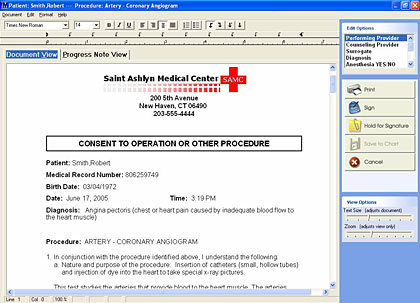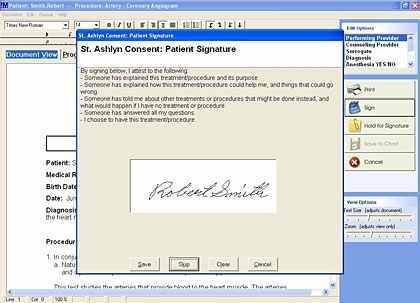Technology Applications: Informed Consent Enters a New Age
November / December 2005
Technology Applications
Informed Consent Enters a New Age
Informed consent serves an important role in hospitals across the country. Typically packaged as a single form or series of forms, the informed consent process ideally serves as a way to educate patients about conditions, treatment alternatives, benefits, and risks of a procedure. Optimally, this shared decision-making process bolsters and refines the knowledge patients have gleaned from discussions with their healthcare providers.
Too often, however, patients have a vastly different experience with informed consent when they enter the hospital to undergo a procedure. For example, a study conducted by Bottrell, et al. (2000) examined the completeness of 540 consent forms from 157 hospitals nationwide. Of these, only 26.4% included all four of the basic elements of informed consent: risks, benefits, alternatives, and nature of the procedure. Eighty-seven percent noted the general possibility of risk, but less than half provided specific information. Alternatives were noted in 56.9% of the forms, and benefits appeared in only 37%, though most of these were general references rather than specific information.
This myriad of shortcomings may lead to significant patient safety and quality of care risks like the selection of inappropriate or undesired therapies, delays in getting procedures started, increased patient anxiety, and poor compliance with pre-procedure and post-operative instructions. It has been estimated that 45% of wrong-site surgeries could be eliminated simply by having a properly completed consent form (Campbell, 2004).
 |
| Courtesy of Dialog Medical |
The correlation between improved patient safety and informed consent is so strong that enhanced informed consent was singled out as being among the top evidence-based patient safety practices advocated by the Agency for Healthcare Research and Quality (2001). So how can these organizations improve this critical communication process? The answer is to use technology to standardize and automate the process.
A New Way
Automated informed consent applications put a library of relevant and reproducible materials at the provider’s fingertips — making it easy to educate patients and document consent. Providers can access treatment information and answer patient questions regarding surgical site locations and diagnoses or enter case-specific considerations regarding use of blood products, the need for anesthesia, and the procedure’s success rate. The most advanced applications even allow providers to capture demographic information from an electronic medical record (EMR) system and include it in the form.
As a result, informed consent documents are completely customized to a patient’s specific circumstances. Plus, all information is written in jargon-free, plain English. Some of the leading applications allow a progress note detailing the informed consent encounter to be automatically posted to the patient’s chart in an EMR system. Such applications also allow a digitally signed copy of the informed consent document to be saved to the hospital’s document management system. This level of integration eliminates the potential for transcription errors, another patient safety concern.
The Benefits of Automation
Hospitals realize several benefits through an automated, standardized informed consent process, chief among them improved patient safety and quality of care. Patients today come to providers armed with an array of information compiled from the Internet and other resources, not all of them trustworthy. They seek greater knowledge of the procedures they will endure, the challenges they will experience during recovery, and the lifechanging habits they will have to practice for a healthier future.
The deep knowledge available in automated informed consent applications offers a treasure trove of trusted information that providers can easily customize and share with patients. In turn, patients become care partners in the informed decision-making process by educating themselves about their health and well-being. By paying attention to their own care, patients themselves enhance their own safety.
In addition to the benefits of improved patient safety and quality of care, hospitals have found that automated informed consent applications give them the opportunity to:
- Improve patient information management. Automated informed consent applications offer digital capture of patient, provider, and witness signatures ensuring the completion of valid documents.
- Reduce the risk of litigation. Patients are much less likely to sue if their physicians communicate effectively with them by answering all questions and fully informing the patients of all risks and alternatives associated with their treatment (Mello, 2005).
- Reduce transcription errors and staff time required for transcription. Time spent compiling, managing, and recording patient information drops when the process is digitized and providers and staff can quickly access the informed consent document.
- Improve reimbursement: Providers using automated informed consent applications may suffer fewer claims disputes, repayment demands, or penalties from payers such as the CMS that have established guidelines for informed consent documents.
- Reduce delays due to lost or misplaced paperwork. Access to real-time patient data removes potential delays in costly operating room time while missing consent documents are located or replaced.
- Achieve heightened compliance with standards. The use of automated informed consent applications enables hospitals to comply with existing and evolving standards from JCAHO, state regulators and other organizations.
 |
| Courtesy of Dialog Medical |
Informed Consent in Action
Hospitals that have used automated informed consent applications to standardize and automate the informed consent process see a positive impact on their processes within months of implementation. The Veteran’s Health Administration (VHA), for example, launched an Electronic Support for Patient Decisions (ESPD) in 2004 and piloted it in five hospitals before rolling it out system-wide this year.
As part of this initiative, VA providers used an automated informed consent application to generate procedure-specific consent forms and education documents for thousands of diagnoses and treatments. Through the pilot study, the VHA found that after using the application for just a few months, hospital staff eliminated the problem of lost consent forms and reported no more incidents of physicians failing to describe all appropriate alternatives and risks that patients need to evaluate in their consideration of various procedures (O’Hara, 2005). The hospitals reported significant time-savings, too, since staff no longer had to track down or replace lost paper consent forms.
For forward-thinking hospitals, a standardized, automated informed consent process plays a tremendous role in improving patient safety and quality of care.
Michael Burke (mburke@dialogmedical.com) is co-founder and president of Atlanta-based Dialog Medical, a leading provider of informed consent and patient education systems for hospitals and physician practices.
References
Bottrell, M. M., Alpert, H., Fischbach, R.L., et al. (2000). Hospital informed consent for procedure forms: Facilitating quality patient-physician interaction. Archives of Surgery135:26-33.
Campbell, D. (2004, June). Listen to the family. Morbidity & Mortality Rounds on the Web.AHRQ.
Centers For Medicare and Medicaid Services. (2004, May 21) Appendix A: Survey protocol, regulations and interpretive guidelines for hospitals. State Operations Manual, Rev 1.
Making Health Care Safer, Agency for Healthcare Research and Quality. (2001). Evidence Report/Technology Assessment No. 43;AHRQ publication 01-E058.
Mello, M. (2005, January 15). Diagnosing malpractice insurance rates. Interviewed by S. Simon, Weekend Edition,NPR Radio.
O’Hara, R. (2005). Electronic support for patient decisions: Automating and integrating the informed consent process. 21st Annual TEPR Conference: Salt Lake City. May 14-15.
